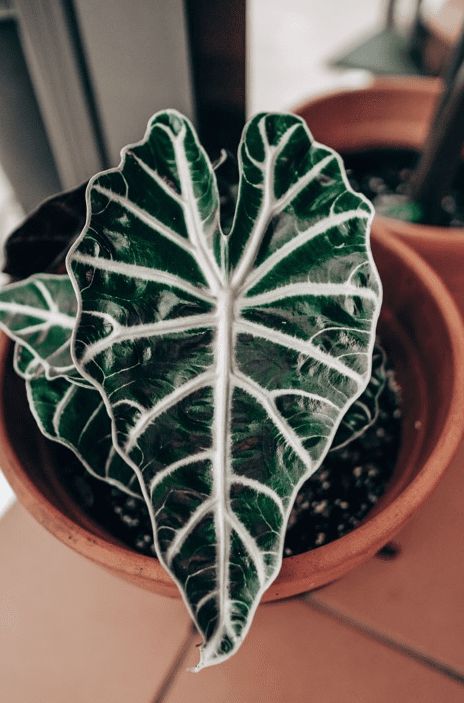Alocasia Polly
You’ve probably seen the Alocasia Polly, also known as African Mask Plant, on social media or garden stores. The Alocasia Polly’s unusually shaped leaves and bright nerves will make you swoon from afar.
The Alocasia Polly, like other Alocasias, has particular needs and may not be the best choice for beginners.
You will care for other advanced plants if you learn how to care for an Alocasia Polly.
I am not a big fan of growing persnickety plants in my outdoor landscape or my indoor garden.
If I have to linger over a plant and give it constant attention and worry about its survival, I am afraid I lose patience and usually discard it.
This attitude is much more pervasive in my outdoor garden than it is in my indoor garden, and I think the reason for that is I am so busy in the summer that I don’t have time to coddle a particular plant.
During the winter, however, I garden at a much more leisurely pace and will sometimes attempt to grow a demanding plant, although the plant has to be special and be worth the effort.
Lately, I have seen such a plant in several garden centers that I think would indeed be worth some extra effort if it was added to my indoor garden, and that plant is the African mask plant.
Its real name is Alocasia Polly, although it is sometimes called the African shield plant or the Kris plant.
To underline how misleading common names for plants can be, the plant is not an African plant; it was given these common names because its leaves resemble the hand-carved ceremonial masks of Africa. The plant origin in the tropical regions of the Philippine Islands.
African Mask is a stunning foliage plant whose leaves have clean lines and crisp, defined color. They are deep dark green and appear almost black in the right light. There are 40 species of Alocasia, and some have blacker leaves than others.
The leaves are long — about 45 centimeters long — and pointed. The shiny surfaces of the leaves are accented by silvery-white veining and deeply scalloped edges, which are outlined by the same bright white color.
How to care for an Alocasia Polly
Alocasia Polly plants grow about 30 to 50 centimeters high and are quite wide because of their large leaves, which project diagonally from the plant base from which they emerge.
The plant is rhizomatous, meaning it grows from spreading rhizomes just beneath the soil, with their tops clearly visible on the soil surface.
When re-potting the Alocasia Polly plant, it is vital that the tops of the rhizomes not be covered, or the plant will die. That is just one of the specific requirements that this plant demands.
It is also very particular when it comes to the planting medium if it is kept happy. The medium must have excellent drainage and be well aerated — including sand and perlite in the mix will provide this requirement, and the soil must retain moisture — so there must be some peat moss in the mix.
Alocasia Polly requires high humidity, and this is the requirement that makes the plant so challenging to grow. Using a pebble tray is mandatory, and misting when possible is a good idea, as is including the plant in a plant grouping so that it can take advantage of the moisture given off by its companions.
Although the Alocasia Polly plant makes a wonderful stand-alone specimen, for the above reason, it is not always possible to exhibit it in this fashion. When used by itself, it will add drama to the interior of a home with modern décor.
Preferring bright indirect light, the African shield plant will not tolerate direct sun, which will damage its leaves. It likes warm temperatures, and it should not be located where it will get chilled during the winter.
It tends to go dormant in the late fall and early winter and, in fact, may lose some of its leaves. During this time, just enough water should be supplied to keep the soil damp; at other times of the year, while the plant is in active growth, the soil should be kept moderately moist and not be allowed to dry out.
Maintenance of this plant includes wiping the leaves to remove dust and keep them looking attractive and keeping an eye out for spider mites and scale, which are the two pests most likely to attack this plant.
If you are up to a challenge and want a gorgeous plant that will create a focal point in your home, whether used as a stunning specimen or as a centerpiece in a plant grouping, the
Alocasia Polly (African shield plant) might be just the plant you are looking for.
Be prepared, however, to give it the TLC that it demands.























